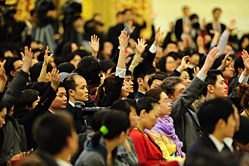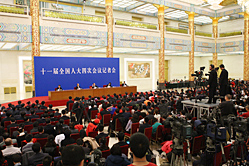|
 |
 |
|
MEDIA FRENZY: Journalists compete for a chance to ask questions at Premier Wen Jiabao's press conference (REN YONG) |
THE MAIN EVENT: Premier Wen Jiabao's press conference is the most-watched event during the session of China's top legislature this year (JIANG XIAOYING) |
And since 1994, the Chinese yuan has appreciated by 57.9 percent against the U.S. dollar. Our practice has been to de-peg the Chinese yuan from the U.S. dollar. We pursue a managed and floating RMB exchange rate regime on the basis of market supply and demand, and with reference to a basket of currencies. We will continue to make the RMB exchange rate more flexible, in line with changes in the market supply and demand. At the same time, the appreciation of the Chinese currency should be a gradual process, because we must bear in mind its impact on the Chinese businesses and our employment situation. We must ensure overall social stability in this process.
Housing prices
It is of utmost importance to ensure the implementation of policies aimed at curbing housing prices. The Central Government will enhance checks over local governments' efforts in curbing housing prices. A strict accountability mechanism will be implemented.
The Central Government will closely follow the development of the country's real estate market to make more effective policies.
Local governments should fulfill their responsibilities of regulating the real estate market. First of all, local governments should make their targets public in lowering housing prices and publicize related policies.
Speeding up the construction of welfare apartments is a key measure to curb housing prices. It will cut demand and help solve the problem of the real estate market.
China will build 10 million welfare apartments respectively in 2011 and 2012. A total of 36 million welfare apartments will be built from 2011 to 2015.
Most of the welfare apartments, except those renovated from bungalows, will be used for low-income renting.
The Central Government will appropriate 103 billion yuan ($15.67 billion) to local governments for welfare housing projects. Local governments should expand investment in welfare housing and extensively utilize social resources.
The government will give priority to the land supply of welfare housing.
Welfare apartments must be of high quality, safe and environment-friendly. It is a great opportunity for China's real estate industry. Losing it would be a shame.
With respect to the construction of these low-income housing, we must at present formulate the management and return mechanisms so that we can put in place a complete system governing the construction, management and return of these houses, and ensure the good quality and efficiency.
Non-public economy
Our policy in this field is that we will unswervingly consolidate and develop the public sector of the economy, and at the same time, unswervingly support, encourage and guide the development of the non-public sector of the economy.
In 2005, the State Council formulated the "36 Guidelines" on encouraging and supporting the development of the non-public sector. Last year, we introduced the "New 36 Guidelines" on encouraging and supporting the non-governmental investment. Policy supports are already large in number.
We will treat all enterprises of different ownerships as the same in terms of law and policy including fiscal, taxation, financial and marketing access policies and measures. We encourage these different economic entities to compete with each other and reinforce each other in their development.
So why do some private enterprises still feel that prospects are depressing and why do they feel that the problems of so-called "glass door" and "spring door" (invisible or visible barriers in their development)? I think it is mainly down to problems in implementation. Actually the "New 36 Guidelines" can be seen as a supplement to the first set of "36 Guidelines," because they spell out policy arrangements and market access in more detail. We are now formulating detailed rules for the implementation of the "New 36 Guidelines," and I believe these two documents will help boost the development of the non-public sector.
I don't think we have the problem that state-owned enterprises forge ahead while privately-held enterprises fall behind. Nor do we have the opposite problem in China. In the past 30 years and more of reform and opening up, we should recognize that big development has been achieved in both the public sector and non-public sector of the Chinese economy. I don't want to spend too much time talking about the public sector at the press conference today.
I'd like to point out that now the private investment has accounted for over 50 percent in the total fixed assets investment nationwide. In the development of industries in China, those privately-held enterprises have been growing faster than their state-owned counterparts in terms of the number of the businesses, their output value, total assets and payrolls. This is a fact that we must recognize.
The proportion of the public sector in the total economy is declining. However, the public sector is still the lifeline of the national economy. The state-owned enterprises are now deepening their reform. They have established a modern corporate management system through joint-stock transformation and introduced non-governmental capital and investment. All these are in the interest of the healthy development of the public sector.
Urban-rural gap
In recent years, farmers' incomes in China have been rising fairly fast. Last year, farmer's cash income reached 5, 919 yuan ($900.63), and for the first time, it increased faster than urban residents' disposable income. It rose by over 10 percent. This is indeed encouraging.
 |
|
FULL OF POTENTIAL: Farmlands in Donglan County, southwest China's Guangxi Zhuang Autonomous Region. Premier Wen Jiabao pledged greater efforts to develop rural areas at his press conference on March 14 (ZHOU ENGE) |
There are three main sources of a farmer's income. First, in 2006, we fully rescinded agricultural taxes, and in that year, the Central Government allocated 132.6 billion yuan for this purpose. At the same time, we have raised production subsidies for farmers and this year, the figure will exceed 120 billion yuan ($18.26 billion).
In rural areas, we have introduced free nine-year compulsory education. We have abolished the textbook fees and expenditure for living on campus for rural poor students. Moreover, the secondary vocational education has been made free of charge for rural students and students who have agriculture-related majors. This is an important source of increasing farmers' income.
Second, and more importantly, farmers no longer face discrimination if they choose to migrate to work in the cities. Now we have about 242 million rural migrant workers working in the cities and their wage income accounts for about 50 percent of their total income.
Third, some farmers also have property income. All these are important aspects of raising farmers' income. It is important we must not be overoptimistic in this aspect, because our agricultural foundation is not yet solid, and we have yet to put the increase of farmers' incomes on a steady course. To continue to raise farmers' income is a very important aspect of our efforts to address income distribution inequalities. Many efforts remain to be made on this front.
For example, over the past several years, the prices of agricultural products have risen by 20 to 40 percent. This year, we will build on that basis and continue to raise the minimum purchase prices of some grains. At the same time, we will take active and steady steps to reform the household registration system so that those migrant workers who meet certain eligibility requirements will become urban residents. At the same time, we will also address migrant workers' needs in their life and work, including training, the schooling of their children and their social security coverage.
Counter-financial crisis
The international financial crisis has exerted a huge impact on China.
| 